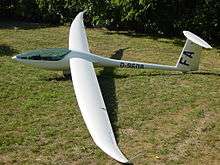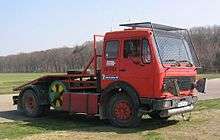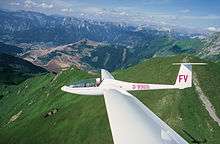Akaflieg Karlsruhe
| Type | Non-profit |
| Founded | 1928 and 1951 |
| Headquarters | Karlsruhe, Germany |
| Membership | Students and University faculty |
| Field | Aviation research |
| Number of Members | 30 (in 2015) |
| Website | www.akaflieg.uni-karlsruhe.de |
Akaflieg Karlsruhe is one of ten flying groups (Akaflieg) attached to German universities. Akaflieg is an abbreviation for Akademische Fliegergruppe, an academic group of students working with a German University. The Akademische Fliegergruppe Karlsruhe e.V. (Akaflieg Karlsruhe) - (Academic Aviator Group Karlsruhe) is a group of students enrolled at Karlsruhe Institute of Technology, who are involved with the development and the design of gliders, as well as research in aerodynamics.
History
Akaflieg Karlsruhe from 1928 to 1933
In the winter semester of 1927/28 a glider group was founded by Karl Töpfer, Assistant at the chair for motor vehicles with a teaching assignment for aircraft technology. The association was registered as Academic Flying Club Karlsruhe 1928. The hang-glider, a large wing equipped with a passenger harness called „Brigant“/"Bandit" was taken over from the Glider Club Karlruhe, which had just been dissolved. Until 1933 three glider planes where built, named „Zögling“/"Pupil", „Hol’s der Teufel“/"Let the devil get it" and „Karlsruhe“. On May 13, 1933 the Akaflieg Karlsruhe was dissolved. The entire equipment was repossessed to the Karlsruhe grouping of the German Aviation Federation.
.jpg)
Re-foundation 1951
Glider flying was allowed in Germany on May 22, 1951 on which the new Academic Flying Group of Karlruhe was officially founded. on its first day it 78 members. Thanks to the support of many friends and sponsors, the fleet rapidly expanded. In 1954 a two seater (model Kranich III) was purchased and got the name „Walter“. In 1955 a new Doppelraab V6 named „Studiosus“ and a motor-plane Bücker 181 "Bestmann" were added to the fleet. A self-built L-Spatz 55 was soon built by the Akaflieg. Mid Sixties work on the project AK-1 started. On January 9, 1971 at 12:31 Central European Time AK-1 was airborne on its own propulsion. The first Prototype of Akaflieg Karlsruhe after the war had proven itself.
The Seventies to Eighties
Flight trials of the Ak-1 were undertaken in the beginning of the seventies. On October 27, 1973 the assemblee decided to launch a new project. AK-2 should be a powerful motor-glider out of Fiberglas. The project was never finished. In parallel flight data calculators for glider flying had been conceived and constructed. AK-3 became a project and a finished flight computer with electric variometer and glide slope indicator was borne, which was even produced in a small series. AK-3R was completed as approach slope calculator The Ak-4 project was a in cooperation with the Institute for climate research and meteorology at the Karlsruhe Institute of Technology. Climatic data over the Upper Rhine Region was measured with an airplane purpose built with special equipment for in flight data collection.
Akaflieg Karlsruhe today
Akaflieg Karlsruhe has a workshop on the west campus of the Karlsruhe Institute of Technology. The students usually work off the required 300 hours per year there. The DG-1000 with a 400-N-Turbine (AK-9) is finished and in flight trials. The main project is the construction of AK-X, a pure wing 15-class glider. The flying activities, with winch hauling, are held on the glider field of Rheinstetten, close to the fair of Karlsruhe since the airport of Karlsruhe-Forchheim was closed.

Gliders/ Prototypes
Aircraft designed and/or built at Akaflieg Karlsruhe include:
- Akaflieg Karlsruhe AK-1 "Mischl" self-launching sailplane
- Single seat glider: steel tube frame construction with fiberglass hull, 15 m of wingspan fitted with a retractable 4 cylinder, two stroke, 28 HP motor, type F10A from Hirth industries.
- Akaflieg Karlsruhe AK-2[1]
- The conception thought of an adaptation of a Glasflügel 604 glider with a motor remaining in the hull, which was a novelty in the Seventies. The project was cannced in favor of AK-5 after 16 years.
- AFK-3

- A single engine Winch was conceived as a novelty, using one engine for driving the truck on the road and hauling the gliders into the air. The winch is hydro-electric and the winch operator uses the passenger seat instead of a separate operator cabin.
- Akaflieg Karlsruhe AK-5 "Ardea"

- Single-seat standard glider in Fiberglass construction. The hull is a Glasflügel 604. The wings have the shape of a Falcon, a prototype designed by Hansjörg Streifeneder (maiden flight 1981). The aim of the project was to pass on the knowledge and incorporate modern, less expensive construction methods as fiberglass. It can be used in instruction because of easy handling. The first flight was June 1, 1990.
- Akaflieg Karlsruhe AK-5b "Otto K.K."
- This is a development of AK-5 with "winglets" and rebuild hull interior. New, easier steering mechanics allow student pilots to fly and new materials are lighter. The first flight of AK-5b was 1996.
- Akaflieg Karlsruhe AK-8
- Single seat 15m standard class glider. New elliptical shaped were built with an aluminum mold. The hull is a DG-600M. Maiden flight of AK-8 was in 2003. After a crash a new left wing was finished in 2009. Improved wings with winglets and improved performance were added in 2014.
- Akaflieg Karlsruhe AK-9 or DG-1000J D-KAKJ "Jet"

- A 400N turbine was installed in a two seater DG-1000. In Cooperation with the Institute for Thermal Flowengines at the KIT the behavior of an AMT Titan Jet Engine by the Dutch producer Draline were researched and improved with a silencer.
- AK-X

- A pure wing glider-prototype with improved handling and performance is currently being built, inspired by the pure-wing conception of the Horten brothers and based on the experience of the SB-13 built by Akaflieg Braunschweig. A 1:2 model flew mid 2015.
References
Bibliography
- Frank-Dieter Lemke; Rolf Jacob (June 2010). "Forschen – Bauen – Fliegen Die Akademischen Fliegergruppen (Akaflieg) in Deutschland bis 1945". Flieger Revue extra (in German). 1 (29): 18–31.(German)
External links
- Akaflieg Karlsruhe (German)
- Akaflieg Karlsruhe homepage
- sailplanedirectory.com
- idaflieg.de
- centennialofflight.net
- ntrs.nasa.gov